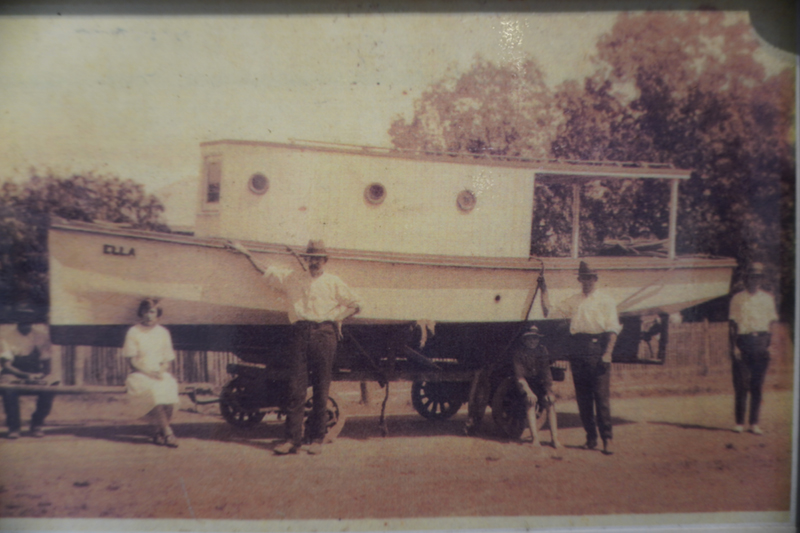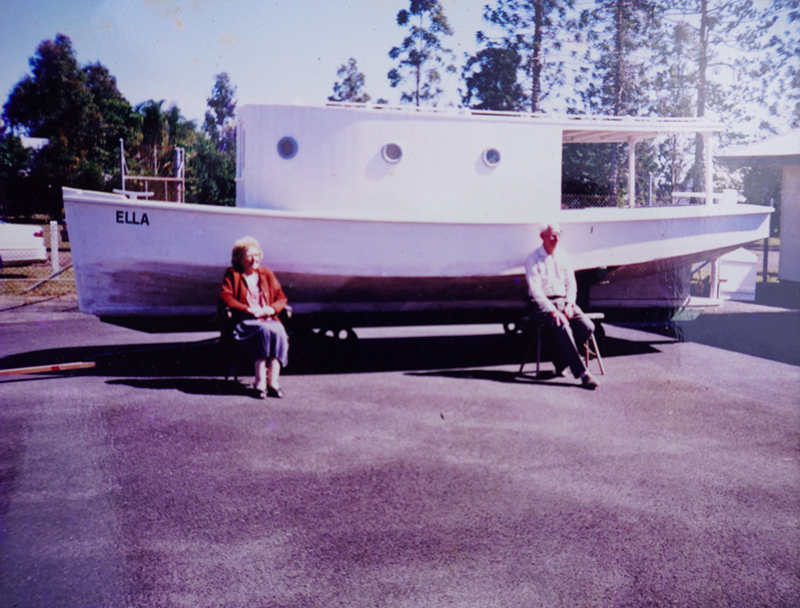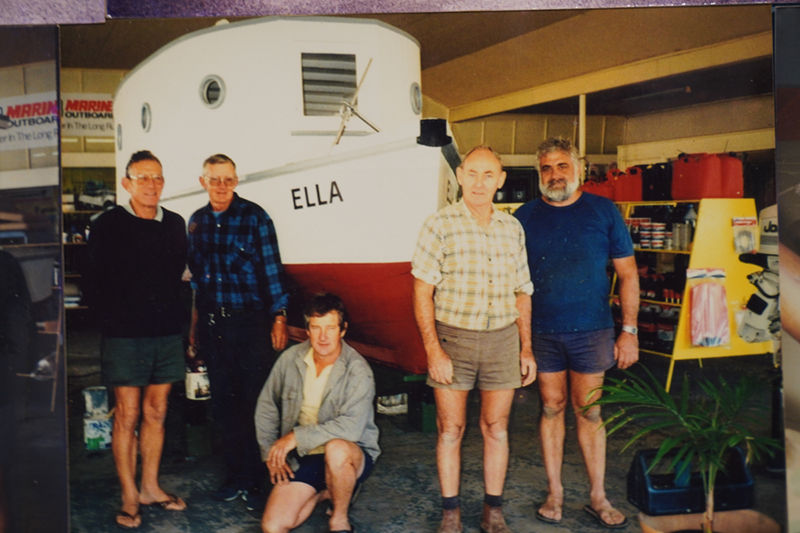MV Ella
The M.V. Ella is believed to be the oldest surviving vessel which had remained on the register of the Port of Maryborough for its entire working life.
Construction by Henry Hume
The MV Ella was constructed in 1920 by Henry Hume at his home in Saltwater Creek Road. Maryborough.
Henry Hume was an average family man who, like a large percentage of men who lived in Maryborough. worked at Walkers Limited. He also raised 15 children. With such a large family to support, there would not have been much left out of the weekly pay packet to afford building material. As a result of the shortage of money. Henry was forced to remove the ceiling of the family home to construct the cabin on the Ella. His wife's thoughts on this are unknown!
Year Built: 1920 by Henry Hume. Restored from 1995 to 1999.
Length: 6.88m
Beam: 2.46m 'Beam' of a boat measures the width at the widest point at the boat's nominal waterline, where the hull [the body of the boat] meets the surface of the water.
Draft: 0.83m 'Draft' of a boat is the vertical distance from the waterline to the bottom of the hull and determines the shallowest water the boat can safely navigate in. The draft increases through the weight of any load, i.e. people, fuel etc.
Construction: Local timber and copper fastenings Design. Hard chine design, referring to the sharp change in the angle in the cross section of the hull. A 'sharpie' is typical of the low cost. easy to build vessel at the time of construction.
Engine: First engine installed was a CCM single cylinder petrol marine engine [1920], Second engine was a 4 cylinder Rugby car engine [1930s]. Third engine, a Holden, was installed after 1975.
Video by Glen David Wilson
Five Men and a Boat
Henry Humes - commercial fishing
Henry was born in Maryborough in 1884 as the youngest son of Thomas Pen rite Hume and Sarah Ann Hume. immigrants from Kelvedon in Essex, England. who arrived in Maryborough in 1874 on the ship 'St James'. Henry married Alice Casperson and together they had 15 Children. The family lived at 48 Creek Road in Maryborough.
Henry worked at Walkers Limited until taking up commercial river fishing on the Ella in 1920. He retired from fishing and sold the boat in 1935 to Noel Witt. In the 1940s, Henry worked as caretaker at the Maryborough Girls Grammar School. Henry was a member of the Maryborough Rifle Club and also involved in Greyhound racing. He passed away in 1954.
Noel Witt - commercial fishing & pleasure craft
Noel was born in Maryborough in 1918 as one of six children. He spent most of his earlier life fishing. In 1935, he bought the Ella from Henry Hume and, except for the war years, used the boat for commercial fishing until he joined the Department of Harbours and Marine in 1948. Noel sold the vessel to Joe Burns and, on his retirement in 1975, bought the Ella back to be used as a pleasure craft. During his second ownership of the Ella, Noel repowered the boat with a Holden engine. Noel passed away in 1988.
Joe Burns - commercial fishing
Joe was born in 1902 as one of 12 children. The family lived in Granville on the northern side of the Mary River and, from an early age, Joe fished in the Mary River using cord hand lines catching kingfish. In later years, he fished for barramundi, jewfish and kingfish from his flat-bottomed dinghy using nets that he had made himself. He spent his entire working life as a commercial fisherman on the Mary River. From the 1930s, Joe lived with his wife Mary and family in a tin shed at the Lesley Reach section of the Mary River, a good spot for catching fish and also crabs and prawn. He bought the Ella in 1948 from Noel Witt and used the boat until he sold it back to Noel in 1975. Joe passed away in 1981.
Ron Brown - pleasure craft
Ron bought the Ella from Trevor 'Chalky' Witt, the nephew of the late Noel Witt, in 1988 and used the boat as a pleasure craft during his short ownership. He sold her on to Denis 'Denny' Milzewski, a local commercial fisherman, in 1989.
Denis 'Denny' Milzewski - commercial fishing
Denis was born in Maryborough in 1942 and was a professional fisherman all his working life. He purchased the Ella from Ron Brown in 1989 and used the boat as a commercial fishing vessel on the Mary River and the Sandy Strait. He sold the ship in 1994 to the Maryborough City Council to be restored and displayed to illustrate the commercial river fishing industry on the Mary River. Denis passed away in 2005.


The Restoration Group
Maryborough City Council acquired the 'Ella' in 1994 and a group of volunteers from the boating fraternity took on the task of restoring the vessel for display at the Bond Store Museum. Maryborough businesses and members of the public supported the group with donations for the required materials.
The group consisted of:
- Peter Young
- D Patrick
- F McClintock
- D Blackley
- Robert Burns

The Mary River
Name
The Mary River is known as Moonaboola in the local Butchulla language. The river was given the name Wide Bay River in 1842 by the explorer Andrew Petrie, when he travelled up the river in search for sheep grazing land. In 1847, the river was renamed Mary River in honour of Lady Mary, wife of NSW Governor Sir Charles Fitzroy, who died in a tragic accident that year.
Geography
The Mary, as it is often referred to, runs north from its source in the Sunshine Coast hinterland past Gympie, Tiaro and Maryborough, before joining with the Susan River and flowing into the Great Sandy Strait at River Heads.
Around Maryborough the river is tidal and has regularly experienced both minor and major flooding events in the past.
Learn more about the major floods of the Mary at the interpretive display outdoors at Bond Store.
Fauna
The Mary River has provided a rich variety of seafood including fish, oysters and prawns for countless centuries. The river is also home to several endangered species, including the Mary River turtle, the Queensland lungfish and the Mary River cod, Saltwater crocodiles have been encountered in the past and also in recent times - so it's advisable to be on guard, especially at the boat ramps.
Did You Know?
Large Gropers were encountered in the river over the years, reportedly weighing up to 373Ibs [169kg]. On one occasion a fisherman's daughter was attacked by a very large specimen while swimming near the wharf and was lucky to fend the fish off by poking him in the eyes.
Commercial Fishing
Variety of Species / Techniques
Joe Burns was a commercial fisherman on the Mary River all his life and for 27 years the 'Ella' was his fishing vessel. Many of the following stories are based on the memories of his son Bob as told in 'Fishing the Mary River'.
Fishing
To catch the fish you must know it intimately - its movements and where and when to find it. Some parts of the river were fished at the ebb tide while others at the flood tide.
Kingfish, also known as threadfin, barramundi and jewfish, usually staying at the bottom of the riverbed, were caught with a 'set net'. The net was anchored to the riverbed and secured by shore line to the river bank. It was held upright and open by timber poles at the ends and held vertical by a cork line at the top and weight down at the bottom with bricks. The nets needed to be checked every six hours and the catch collected.
Prawning
The main season for Banana prawn was February to May, while greentail prawn (also known as greasy-back or black prawn) were caught during summer.
Bank Scoop
In the early days, bank scoops were used to catch prawn either from the riverbanks or a flatbottomed dinghy. The scoop consisted of a net tied to a rim with a long wooden handle attached. It was cast away and when drawn back large quantities of prawn were caught inside.
Rookster Net
The rookster net, a large, small-meshed haul net had three sections; a deep, middle pocket called the 'bunt' and two wings at either side. It was mainly used at night during the incoming tide and required two to three people to handle it; one holding one end of the net at the bank of the river while the second took a dinghy with the remaining net out on the river and returning towards the shore in an arched line. Using the flow of the tide, large amounts of prawns could be caught.
Making a Living
Nets
Joe Burns made his nets himself using Barbour's bootmaker's linen thread and hand-carved wooden needles for meshing. Once completed. the net was strung on ropes with cork floats along the top and lead weights at the bottom line. The net was then tanned in a solution of boiled down orange mangrove bark. sometimes with the addition of bark from a black ironbark tree. to prevent rotting in the muddy river water.
Getting the Catch to Market
Back on land. the prawns were cooked in water in kerosene tins hung on long poles over an open fire and the cooked prawns were spread out on wooden benches to cool overnight. The following morning, the prawns were washed in salty river water and boxed up for the fish market.
To get his catch to market prior to the late 194Os. Joe Burns rode his push bike ten miles l16kml from Beaver Rock to Maryborough, the fish stowed in bags and hanging over the bar of the bike and across the handlebars and carrier while the prawn were carried in a wicker basket. Sometimes he had to do the trip twice in one day and having to manage boggy tracks in rainy weather. In 1948, Joe bought a car, making the transport a lot easier.
Oysters
The majority of Oysters were destined for the southern markets, first transported on small sailing ships and later by coastal steamers. To avoid paying loading fees under the Wharf Lumpers Act, the oysters were transferred from the oyster boats to the steamers while travelling beside each other.
Fisherman's Wharf
Fishermen from the area, including the Sandy Strait, used the Fisherman's wharf in Maryborough to unload their catch and to stock up on supplies, including fuel as well as ice to keep the catch fresh. The wharf was located opposite the fish depot.
To load the ice onto boats, the street was closed off and trestles with hardwood planks were set up in-between the fish depot and the wharf. The blocks of ice were then slid down edge-on, leaving the planks polished smooth from years of use.
Queensland Fish Board
The Queensland Fish Board was established in 1925 to control the fish market. including quantities and price. marketing arrangements at the Brisbane Fish Market. controlling the activities of the Fishermen's Co-operative Company, and resolving disputes between the Co-operative and the Fish Merchants' Association. The board had several depots along the coast; the Maryborough depot was originally located on the corner of Wharf and March Streets.
Fishermen were compelled to sell their catch to the Fish Board in accordance with a set price. quantity and specifications regarding size. This sometimes led to fish being rejected, which was consequently then sold on the 'black market'.
Visit the M.V. Ella
The M.V. Ella is on permanent display adjacent to the Brolga Theatre carpark at 5 Walker Street, Maryborough